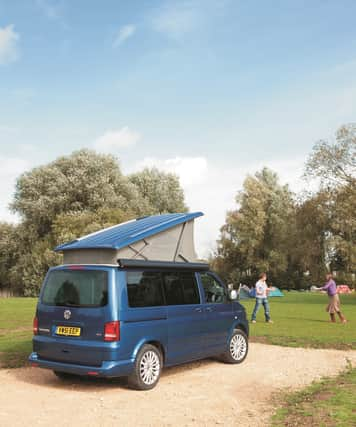Volkswagen California TDI Bluemotion Technology


Volkswagen California TDI Bluemotion Technology
Engine: 1,968cc, four-cylinder turbodiesel
Power: 138bhp and 251lb.ft. of torque
Performance: 0-62mph in 15.7 seconds and 106 mph
Economy: 39.2mpg (combined)
CO2 emissions: 189g/km
Price: £44,615
The Volkswagen California camper van sporting VW51EEP, I suspected, would not prove to be the bearer of a good night’s kip during a two-night stay in the Lake District with my partner and our seven-month-old boy.
But, alas, a friend of mine who is wrapped up in the current trend for Volkswagen Transporters converted into campers — the owner of a stunning example of his own, but also equipped with year-old twins — encouraged the idea so we packed the bacon and eggs and a selection of waterproof clothing and pointed the vans towards Windermere.
Advertisement
Hide AdAdvertisement
Hide AdBased on a formula that dates back to the originally splitty and bricky Volkswagen camper vans of the 1960s and 70s, the California is a compact pseudo motorhome designed around underpinnings that can be found on the T5 Transporter van and Caravelle MPV.
Sat beside the long-wheelbase Transporter that joined us on our trip the Sharpe family California looked worryingly small.
A browse through the specification sheet sent to me by Volkswagen served as some reassurance that we wouldn’t be woefully under-equipped though.
As you might expect from a manufacturer with almost half a decade of experience packaging camper vans, Volkswagen’s engineers have exploited the California compact dimensions to the full.
Advertisement
Hide AdAdvertisement
Hide AdAn on-board toilet or oven might not be included in the specification but they are the only things that aren’t.
Wardrobe space, built-in cupboard space with shelving, a pair of gas hobs, a brutally effective fridge (I made the mistake of turning it up to full power and freezing my milk), a heater and air conditioning unit, two armchairs and two double beds are all among the standard kit.
Tables for inside and outside, a pair of lightweight deck chairs which are neatly zipped inside the boot door, a roll out awning (£385) and a bike rack (£485) were also among the kit on VW51EEP.
The real bonus of the California, though, is that unlike a coach-built motorhome, it could be used day-to-day, a dual purpose that makes its £44,615 price tag that bit more palatable.
Advertisement
Hide AdAdvertisement
Hide AdBarely a squeak or rattle emanated from the fitted units during my test — unlike the motorhome’s I have driven in the past — and Volkswagen’s tried and trusted 138bhp two-litre turbodiesel engine made progress feel quicker than the claimed 15.7 second sprint to 62mph and 106mph top speed.
With cruise control fitted to the California as standard a motorway cruise is a straightforward, relaxed affair and will return something close to the official combined average fuel consumption of 39.2mpg on the evidence of my test. Even the 189g/km CO2 emissions aren’t too shabby.
The two captains chairs up front — they can be spun round and used as armchairs once you set up camp — mean that there’s not accommodation for three up front, as there might be with a Transporter van, and the fitted sideboard only leaves space for two rear-seat occupants. There’s plenty of space back there, though.
The most difficult thing while setting up camp upon our arrival at our chosen site near the village of Crook was my partner after she realised I’d not packed her walking boots or scarf. Damn it.
Advertisement
Hide AdAdvertisement
Hide AdTransforming the California from van into overnight accommodation thankfully proved a breeze.
After connecting the gas bottle and electricity supply all that was left to do was raise the fold-up roof which gives access to double-sized sleeping quarters accessed via a hatch over the cab.
A control panel where you might find the controls for a sunroof on a conventional vehicle allows this to be raised automatically at the push of a button — something my Transporter-driving friend was a a little envious of.
With the rear seats folded into their flat position to create a double bed downstairs the little ‘un could inhabit the largest cot he’d ever slept in and, once the awning was rolled out, we were happy campers.
Advertisement
Hide AdAdvertisement
Hide AdAfter juggling the three babies in our group during an evening meal at a nearby pub the prospect of clambering past a — thankfully asleep — six-month-old to get to our sleeping quarters with a full belly wasn’t something I was relishing.
Although probably the favoured accommodation for younger members of a camping party, it was a breeze to get up, however, and truly comfortable. My 6ft 1inch frame was easily accommodated too.
A blast from the heater the next morning started the day with a sweaty brow (like the fridge, it’s a pretty effective device) but the realisation that we’d all enjoyed a refreshing night’s sleep.
We enjoyed another similarly uneventful night at the camp site and the California proved so quickly adapted from motorhome to people carrier that we used it as transport to the nearby train station for our day-trip to Windermere without any fuss.
Advertisement
Hide AdAdvertisement
Hide AdThe weather, sadly, didn’t emulate the adhere to the words written on our camper van’s exterior as readily as our rejuvenating nights did.
Sleep came more readily than I’d ever anticipated. It must have been the country air. But California the Lake District ain’t.